Estimation of the Evapotranspiration and Crop Coefficients of Bell Pepper Using a Removable Weighing Lysimeter: A Case Study in the Southeast of Spain
Abstract
1. Introduction
2. Materials and Methods
2.1. Study Area
2.2. Description of the Removable Weighing Lysimeter
2.3. Crop Management
2.4. Determination of Evapotranspiration and Crop Coefficients
2.5. Water Productivity
3. Results and Discussion
3.1. Meteorological Conditions
3.2. Crop Evapotranspiration
3.3. Crop Coefficient
3.4. Yield
4. Conclusions
Author Contributions
Funding
Institutional Review Board Statement
Informed Consent Statement
Data Availability Statement
Acknowledgments
Conflicts of Interest
References
- Fernández-Pacheco, D.G.; Escarabajal-Henarejos, D.; Ruiz-Canales, A.; Conesa, J.; Molina-Martínez, J.M. A digital image-processing-based method for determining the crop coefficient of lettuce crops in the southeast of Spain. Biosyst. Eng. 2014, 117, 23–34. [Google Scholar] [CrossRef]
- Escarabajal-Henarejos, D.; Molina-Martínez, J.M.; Fernández-Pacheco, D.G.; Cavas-Martínez, F.; García-Mateos, G. Digital photography applied to irrigation management of Little Gem lettuce. Agric. Water Manag. 2014, 151, 148–157. [Google Scholar] [CrossRef]
- López-Urrea, R.; Montoro, A.; López-Fuster, P.; Fereres, E. Evapotranspiration and responses to irrigation of broccoli. Agric. Water Manag. 2009, 96, 1155–1161. [Google Scholar] [CrossRef]
- Egbuikwem, P.N.; Obiechefu, G.C. Evaluation of Evapotranspiration Models for Waterleaf crop using Data from Lysimeter. In Proceedings of the 2017 Spokane, Washington, DC, USA, 16–19 July 2017; American Society of Agricultural and Biological Engineers: St. Joseph Charter Township, MI, USA, 2017. [Google Scholar]
- Yimam, A.Y.; Assefa, T.T.; Adane, N.F.; Tilahun, S.A.; Jha, M.K.; Reyes, M.R. Experimental Evaluation for the Impacts of Conservation Agriculture with Drip Irrigation on Crop Coefficient and Soil Properties in the Sub-Humid Ethiopian Highlands. Water 2020, 12, 947. [Google Scholar] [CrossRef]
- Ministerio de Medio Ambiente y Medio Rural y Marino Estadísticas Agrarias. Available online: https://www.mapa.gob.es/es/estadistica/temas/estadisticas-agrarias/ (accessed on 15 October 2020).
- Nikolaou, G.; Neocleous, D.; Christou, A.; Kitta, E.; Katsoulas, N. Implementing Sustainable Irrigation in Water-Scarce Regions under the Impact of Climate Change. Agronomy 2020, 10, 1120. [Google Scholar] [CrossRef]
- González-Esquiva, J.M.; García-Mateos, G.; Escarabajal-Henarejos, D.; Hernández-Hernández, J.L.; Ruiz-Canales, A.; Molina-Martínez, J.M. A new model for water balance estimation on lettuce crops using effective diameter obtained with image analysis. Agric. Water Manag. 2017, 183, 116–122. [Google Scholar] [CrossRef]
- Feltrin, R.M.; de Paiva, J.B.D.; de Paiva, E.M.C.D.; Beling, F.A. Lysimeter soil water balance evaluation for an experiment developed in the Southern Brazilian Atlantic Forest region. Hydrol. Process. 2011, 25, 2321–2328. [Google Scholar] [CrossRef]
- Soldevilla-Martinez, M.; Quemada, M.; López-Urrea, R.; Muñoz-Carpena, R.; Lizaso, J.I. Soil water balance: Comparing two simulation models of different levels of complexity with lysimeter observations. Agric. Water Manag. 2014, 139, 53–63. [Google Scholar] [CrossRef]
- Cunha, H.; Loureiro, D.; Sousa, G.; Covas, D.; Alegre, H. A comprehensive water balance methodology for collective irrigation systems. Agric. Water Manag. 2019, 223, 105660. [Google Scholar] [CrossRef]
- Allen, R.G.; Pereira, L.S.; Raes, D.; Smith, M. Crop Evapotranspiration-Guidelines for Computing Crop Water Requirements-FAO Irrigation and Drainage Paper 56; FAO: Rome, Italy, 1998; Volume 300. [Google Scholar]
- Sepaskhah, A.R.; Andam, M. Crop coefficient of sesame in a semiarid region of IR Iran. Agric Water Manag. 2001, 49, 51–63. [Google Scholar] [CrossRef]
- Martínez-Cob, A. Use of thermal units to estimate corn crop coefficients under semiarid climatic conditions. Irrig. Sci. 2008, 26, 335–345. [Google Scholar] [CrossRef]
- Mateos, L.; González-Dugo, M.P.; Testi, L.; Villalobos, F.J. Monitoring evapotranspiration of irrigated crops using crop coefficients derived from time series of satellite images. I. Method validation. Agric. Water Manag. 2013, 125, 81–91. [Google Scholar] [CrossRef]
- Kullberg, E.G.; DeJonge, K.C.; Chávez, J.L. Evaluation of thermal remote sensing indices to estimate crop evapotranspiration coefficients. Agric. Water Manag. 2017, 179, 64–73. [Google Scholar] [CrossRef]
- Vaughan, P.J.; Trout, T.J.; Ayars, J.E. A processing method for weighing lysimeter data and comparison to micrometeorological ETo predictions. Agric. Water Manag. 2007, 88, 141–146. [Google Scholar] [CrossRef]
- Evett, S.R.; Mazahrih, N.T.; Jitan, M.A.; Sawalha, M.H.; Colaizzi, P.D.; Ayars, J.E. A Weighing Lysimeter for Crop Water Use Determination in the Jordan Valley, Jordan. Trans. ASABE 2009, 52, 155–169. [Google Scholar] [CrossRef]
- Bello, Z.A.; Van Rensburg, L.D. Development, calibration and testing of a low-cost small lysimeter for monitoring evaporation and transpiration: Development, calibration and testing of a low cost small lysimeter. Irrig. Drain. 2017, 66, 263–272. [Google Scholar] [CrossRef]
- Benli, B.; Kodal, S.; Ilbeyi, A.; Ustun, H. Determination of evapotranspiration and basal crop coefficient of alfalfa with a weighing lysimeter. Agric. Water Manag. 2006, 81, 358–370. [Google Scholar] [CrossRef]
- Anapalli, S.S.; Ahuja, L.R.; Gowda, P.H.; Ma, L.; Marek, G.; Evett, S.R.; Howell, T.A. Simulation of crop evapotranspiration and crop coefficients with data in weighing lysimeters. Agric. Water Manag. 2016, 177, 274–283. [Google Scholar] [CrossRef]
- Wegehenkel, M.; Zhang, Y.; Zenker, T.; Diestel, H. The use of lysimeter data for the test of two soil-water balance models: A case study. Z. Pflanzenernähr. Bodenk. 2008, 171, 762–776. [Google Scholar] [CrossRef]
- Meissner, R.; Seeger, J.; Rupp, H.; Seyfarth, M.; Borg, H. Measurement of dew, fog, and rime with a high-precision gravitation lysimeter. J. Plant Nutr. Soil Sci. 2007, 170, 335–344. [Google Scholar] [CrossRef]
- Schrader, F.; Durner, W.; Fank, J.; Gebler, S.; Pütz, T.; Hannes, M.; Wollschläger, U. Estimating Precipitation and Actual Evapotranspiration from Precision Lysimeter Measurements. Procedia Environ. Sci. 2013, 19, 543–552. [Google Scholar] [CrossRef]
- Herbrich, M.; Gerke, H.H. Autocorrelation analysis of high resolution weighing lysimeter time series as a basis for determination of precipitation. J. Plant Nutr. Soil Sci. 2016, 179, 784–798. [Google Scholar] [CrossRef]
- Hannes, M.; Wollschläger, U.; Schrader, F.; Durner, W.; Gebler, S.; Pütz, T.; Fank, J.; von Unold, G.; Vogel, H.-J. A comprehensive filtering scheme for high-resolution estimation of the water balance components from high-precision lysimeters. Hydrol. Earth Syst. Sci. 2015, 19, 3405–3418. [Google Scholar] [CrossRef]
- Hoffman, M.; Schwartengräber, R.; Wessolek, G.; Peters, A. Comparison of simple rain gauge measurements with precision lysimeter data. Atmos. Res. 2016, 174–175, 120–123. [Google Scholar] [CrossRef]
- Peters, A.; Nehls, T.; Schonsky, H.; Wessolek, G. Separating precipitation and evapotranspiration from noise—A new filter routine for high-resolution lysimeter data. Hydrol. Earth Syst. Sci. 2014, 18, 1189–1198. [Google Scholar] [CrossRef]
- Young, M.H.; Wierenga, P.J.; Mancino, C.F. Large Weighing Lysimeters for Water Use and Deep Percolation Studies. Soil Sci. 1996, 161, 491–501. [Google Scholar] [CrossRef]
- Ruiz-Peñalver, L.; Vera-Repullo, J.A.; Jiménez-Buendía, M.; Guzmán, I.; Molina-Martínez, J.M. Development of an innovative low cost weighing lysimeter for potted plants: Application in lysimetric stations. Agric. Water Manag. 2015, 151, 103–113. [Google Scholar] [CrossRef]
- Nicolás-Cuevas, J.A.; Parras-Burgos, D.; Soler-Méndez, M.; Ruiz-Canales, A.; Molina-Martínez, J.M. Removable Weighing Lysimeter for Use in Horticultural Crops. Appl. Sci. 2020, 10, 4865. [Google Scholar] [CrossRef]
- METER Group Smart Field Lysimeter. Available online: https://www.metergroup.com/environment/products/smart-field-lysimeter/%20or/ (accessed on 12 December 2020).
- UGT-Team Lysimeter Technology. Available online: https://www.ugt-online.de/en/products/lysimeter-technology/ (accessed on 12 December 2020).
- Aboukhaled, A.; Alfaro, A.; Smith, M. Lysimeters. In FAO Irrigation and Drainage Paper 39; Food and Agriculture Organization United Nations: Rome, Italy, 1982. [Google Scholar]
- Soil Survey Staff. Soil Survey Manual; United State Department of Agriculture: Washington, DC, USA, 1951. [Google Scholar]
- Ministerio de Agricultura, Pesca y Alimentación Guía Práctica de la Fertilización Racional de los Cultivos en España. Available online: https://www.mapa.gob.es/es/agricultura/publicaciones/Publicaciones-fertilizantes.aspx (accessed on 7 February 2019).
- Miranda, F.R.; Gondim, R.S.; Costa, C.A.G. Evapotranspiration and crop coefficients for tabasco pepper (Capsicum frutescens L.). Agric. Water Manag. 2006, 82, 237–246. [Google Scholar] [CrossRef]
- Vidal, J.L. Efectos del Factor Térmico en el Desarrollo del Crecimiento Inicial de Pimiento (Capsicum annum L.) Cultivado en Campo; Universidad Nacional de Tucumán: Tucumán, Argentina, 2011. [Google Scholar]
- Verma, S.P. Análisis Estadístico de Datos Composicionales; Universidad Autónoma de México: Ciudad de México, Mexico, 2016. [Google Scholar]
- Wackerly, D.D.; Mendenhall, W.; Schaeaffer, R.L. Mathematical Statics with Applications, 7th ed.; Learning Cengage; Cengage Learning: Boston, MA, USA, 2010. [Google Scholar]
- Willmott, C.; Ackleso, S.; Davis, O.; Feddema, J.; Klink, K.; Legate, D.; Rowe, A. Statistics for the Evaluation and Comparison of Models. J. Geophys. Res. Oceans 1985, 90, 8995–9005. [Google Scholar] [CrossRef]
- Playán, E.; Mateos, L. Modernization and optimization of irrigation systems to increase water productivity. Agric. Water Manag. 2006, 80, 100–116. [Google Scholar] [CrossRef]
- Shukla, S.; Jaber, F.H.; Goswami, D.; Srivastava, S. Evapotranspiration losses for pepper under plastic mulch and shallow water table conditions. Irrig. Sci. 2013, 31, 523–536. [Google Scholar] [CrossRef]
- Muniandy, J.M.; Yusop, Z.; Askari, M. Evaluation of reference evapotranspiration models and determination of crop coefficient for Momordica charantia and Capsicum annuum. Agric. Water Manag. 2016, 169, 77–89. [Google Scholar] [CrossRef]
- López-Marín, J.; Angosto, J.L.; González, A. El cultivo de pimientos en invernadero y al aire libre. El caso del Campo de Cartagena. Bibl. Hortic. 2017, 1, 1–67. [Google Scholar]
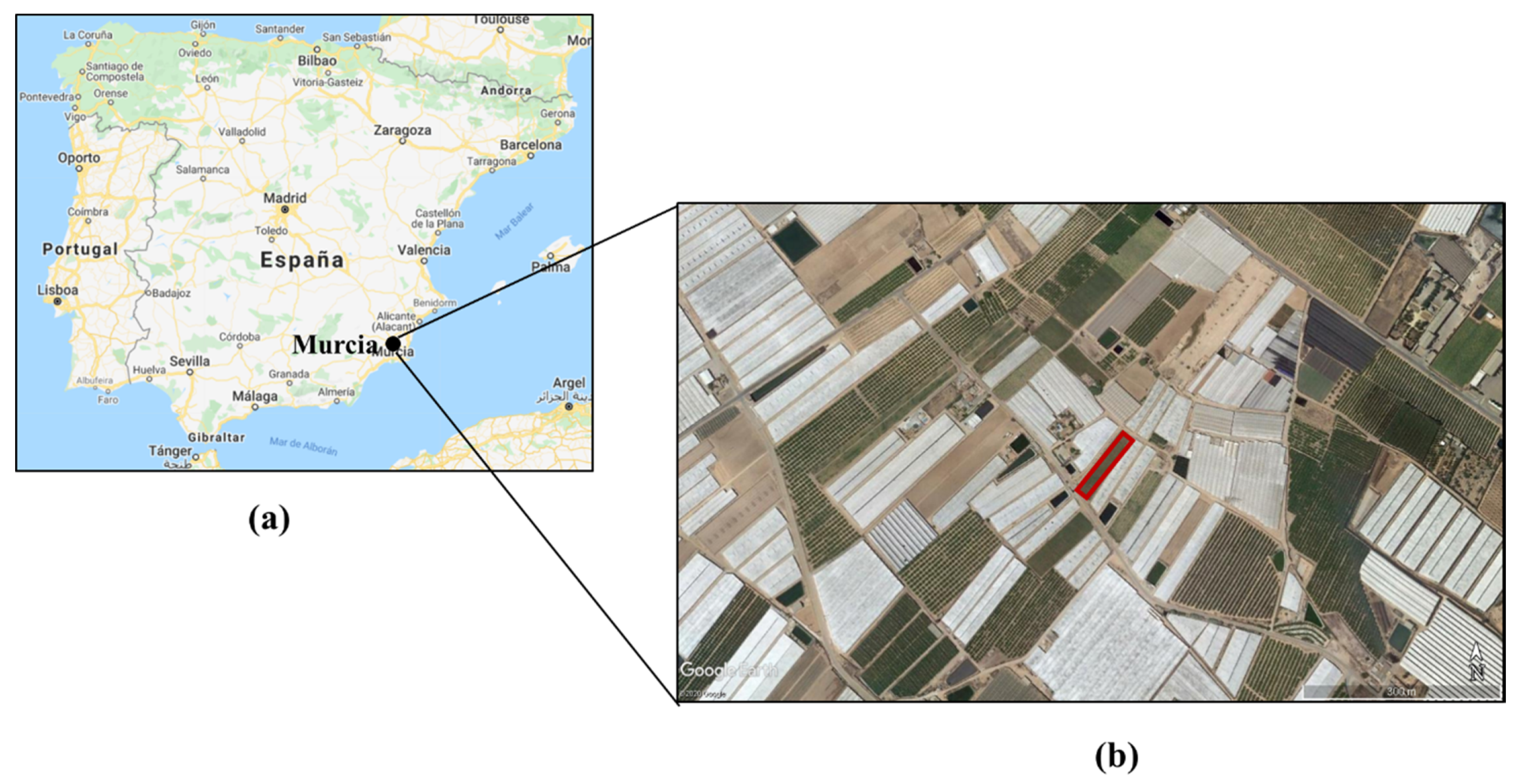
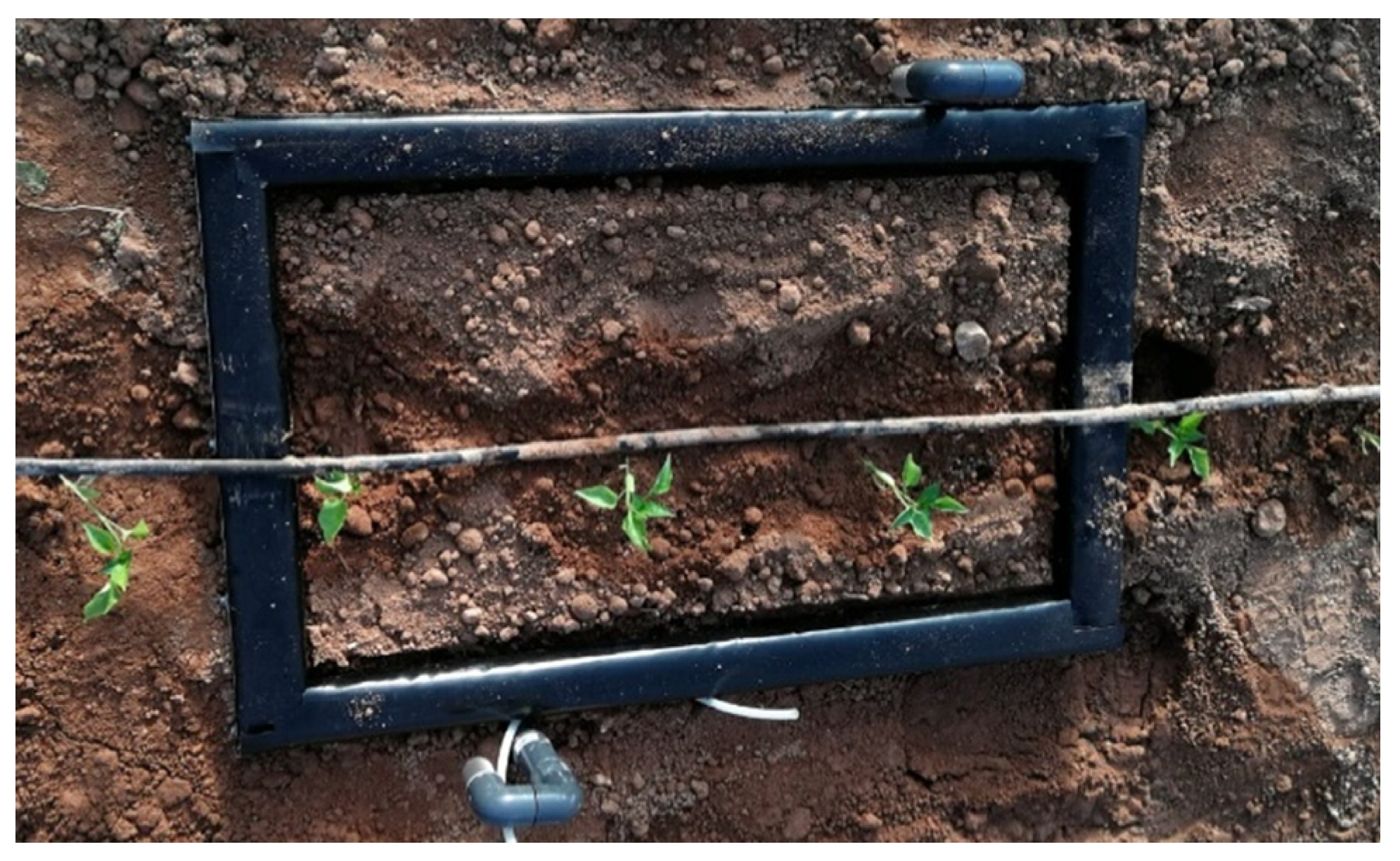
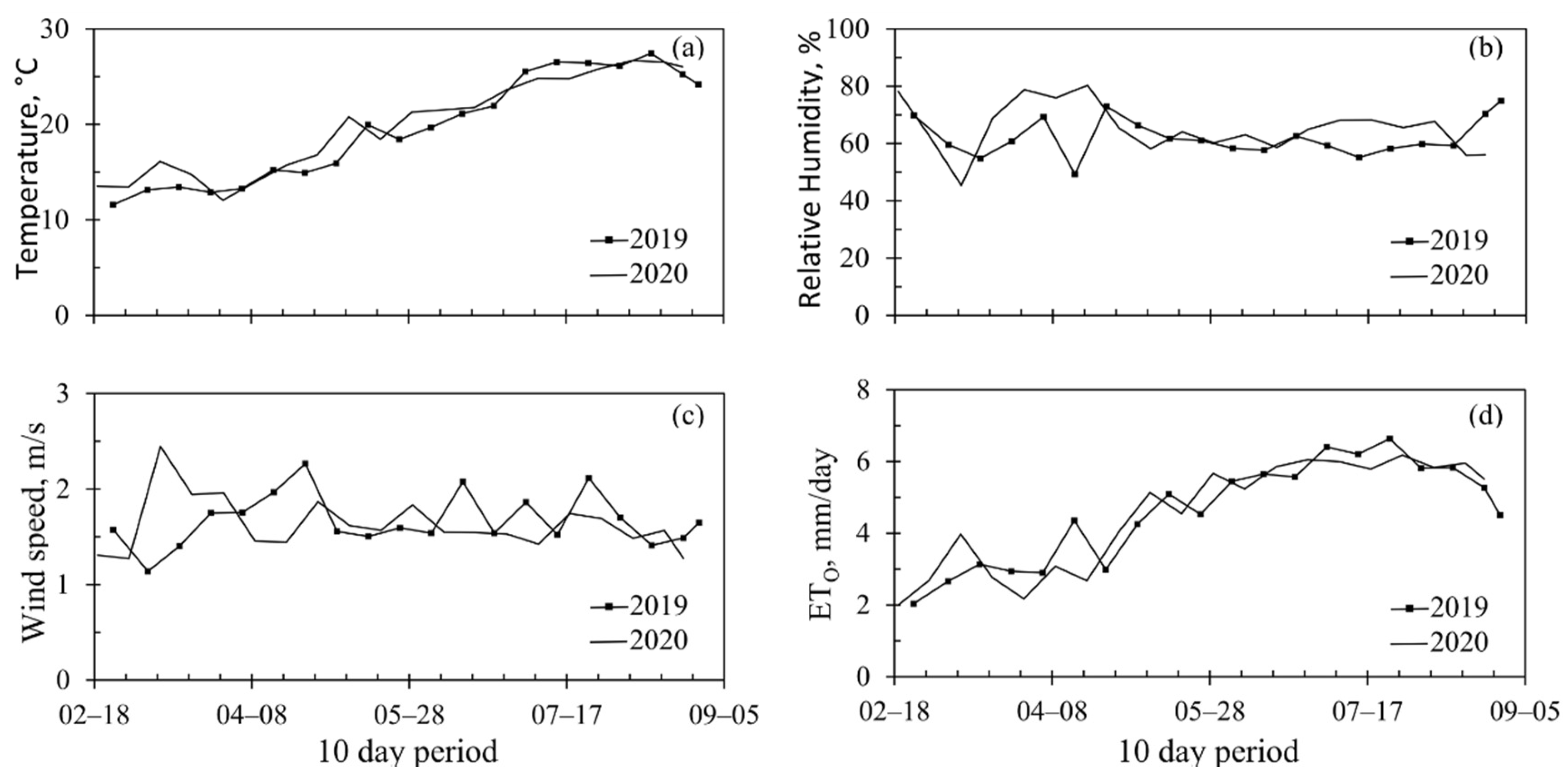
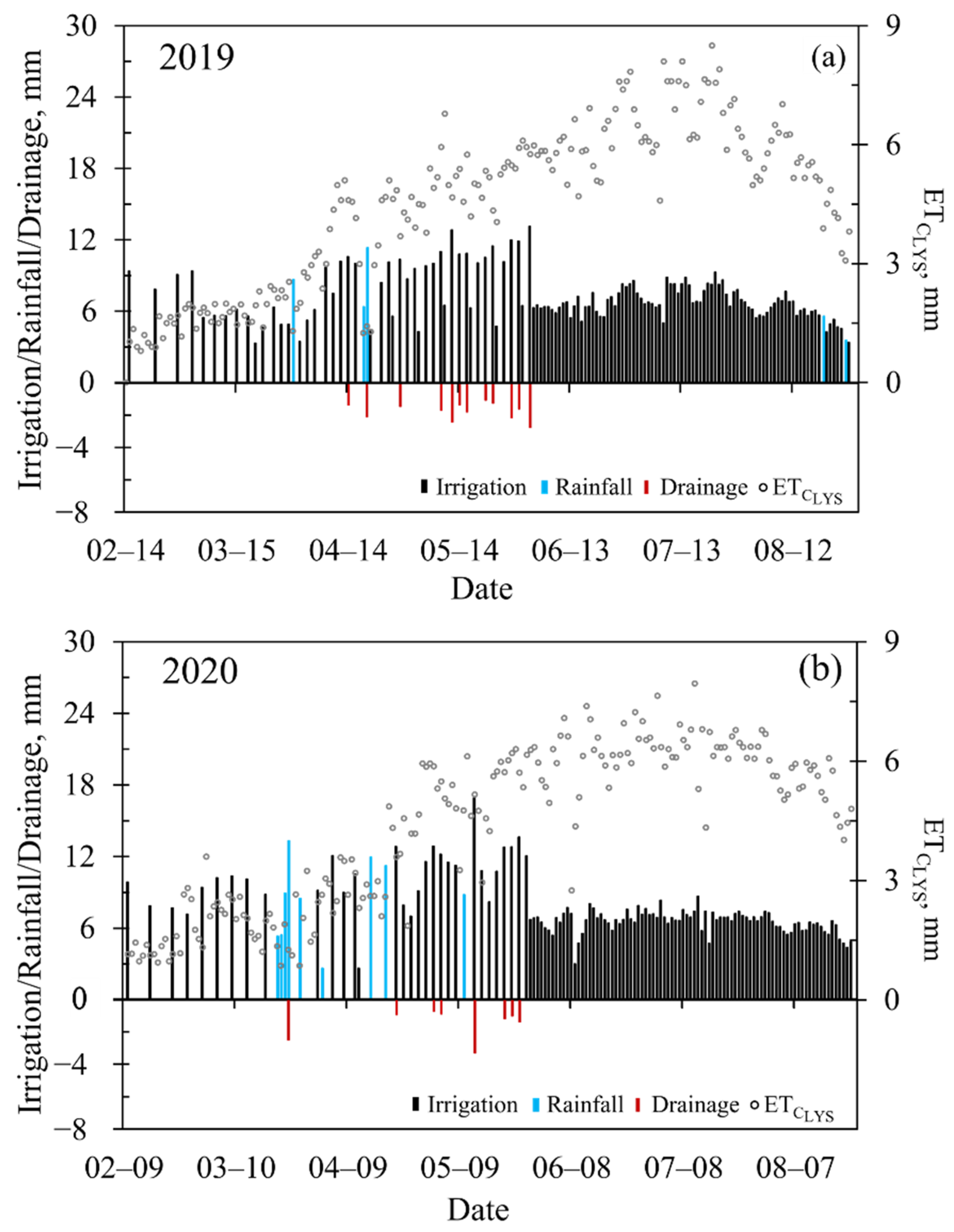
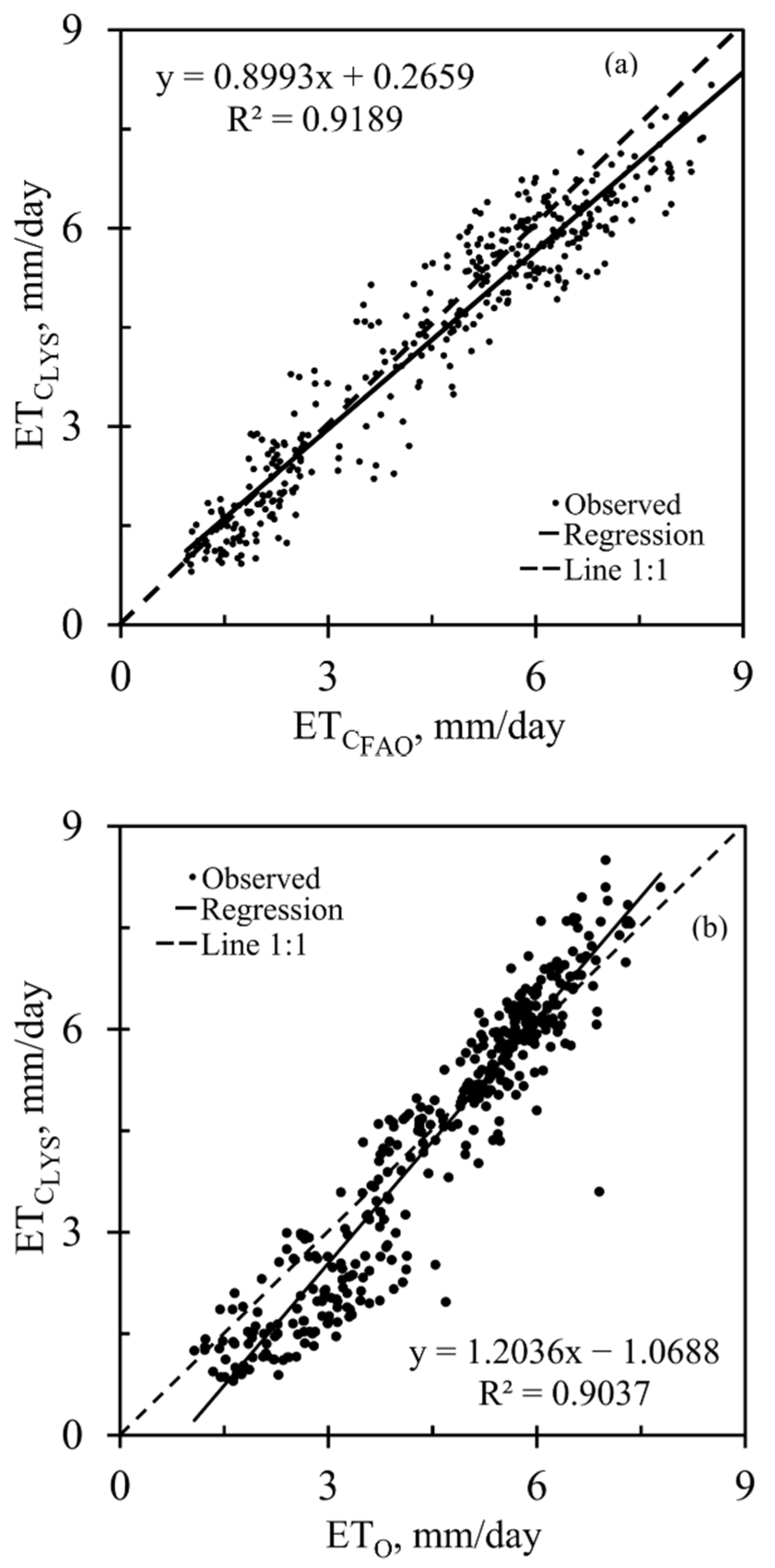
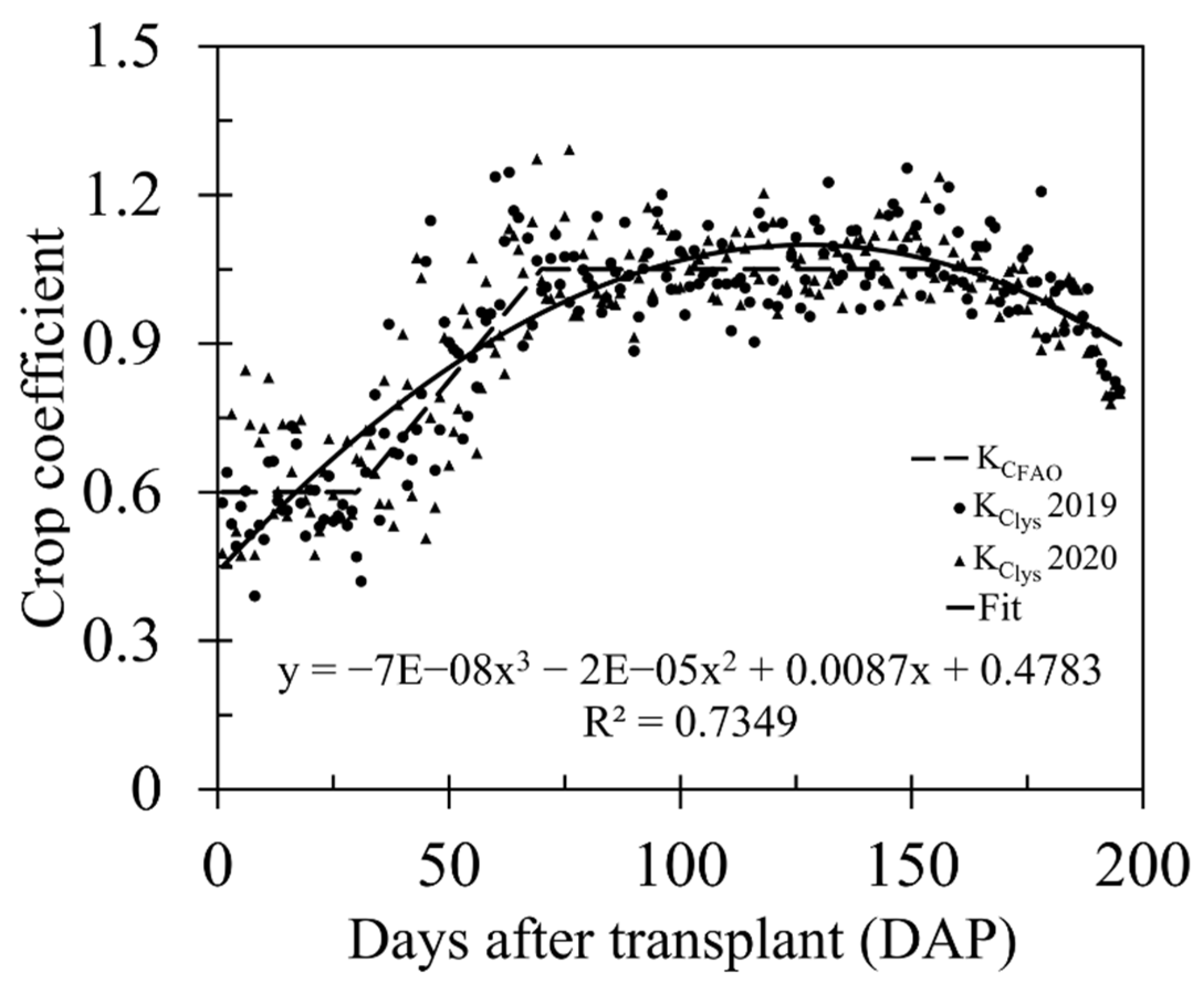
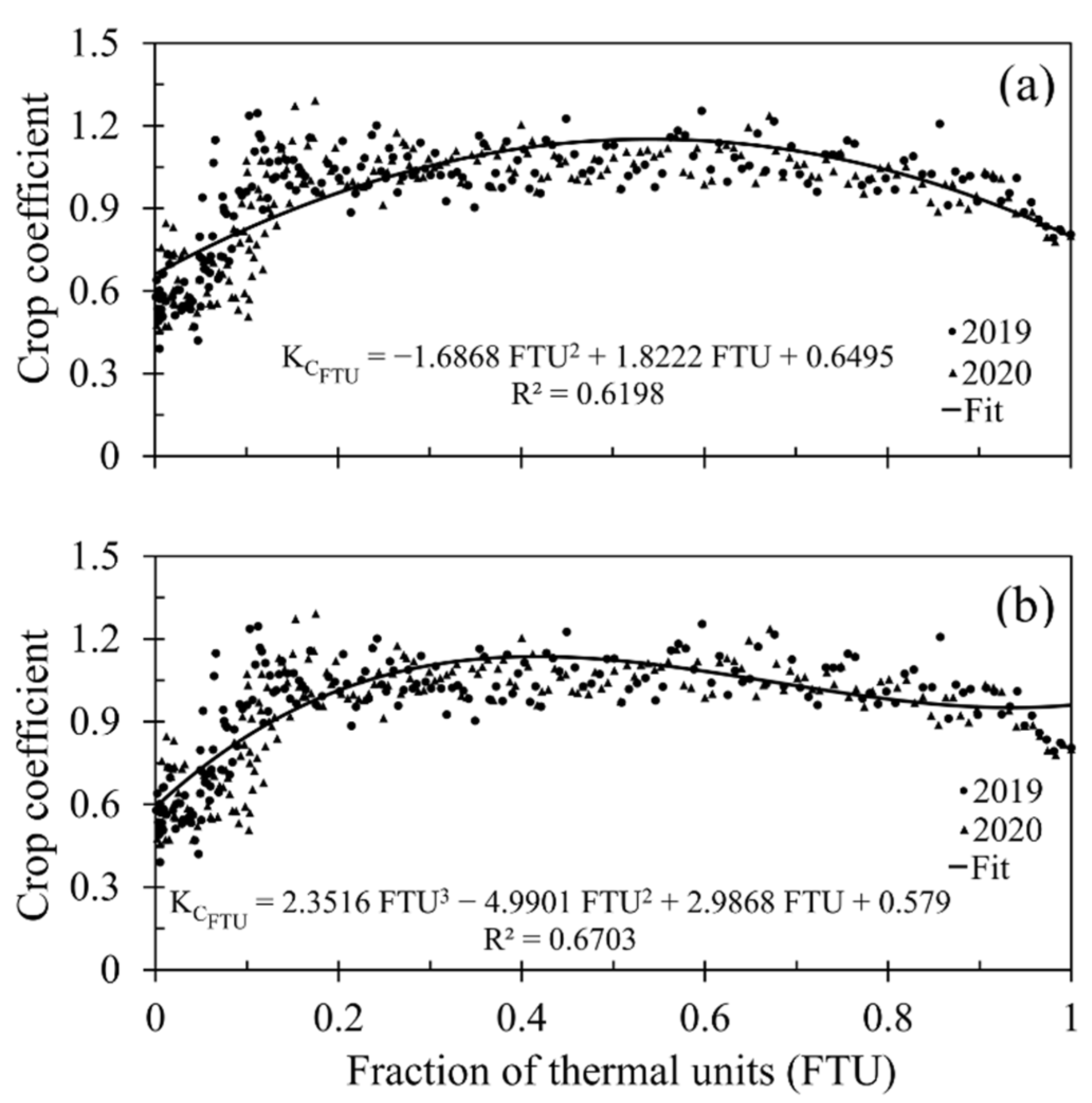
| Season | Irrigation | Rainfall | Drainage | |
|---|---|---|---|---|
| 2019 | 960.3 | 35.4 | 12.31 | 874.4 |
| 2020 | 936.1 | 76.1 | 12.03 | 854.6 |
| Crop Stage | Location | Irrigation Method | Climate | Crop Cycle (Day) | |||
|---|---|---|---|---|---|---|---|
| Initial | Middle | End | Conditions | ||||
| 0.57 | 1.06 | 0.80 | Murcia, Spain | Drip | Temp. 12–28 °C RH 47%–77% Rain <100 mm/season ≈ 860 mm/season | 195 | |
| * | 0.69 | 1.05 | 0.78 | ||||
| ** | 0.65 | 1.06 | 0.93 | ||||
| Allen et al. [12] | 0.6 | 1.05 | 0.9 | Europe and Mediterranean | __ | RH ≈ 45% | 125 |
| Shukla et al. [43] | 0.86 | 1.21 | 1.28 | Florida, USA | Sub-surface | Temp. 17–29 °C Rain 1260 mm/year 267 mm | 100 |
| Muniandy et al. [44] | 0.67 | 0.95 | 0.76 | Kluang, Malaysia | Sprinkler | Temp. 24–30 °C Rain 125–270 mm/month RH 63%–88% | 125 |
| Year | Bell Pepper Yield (t/ha) | Water Productivity (Kg/m3) | Economic Yield (EUR/ha) |
|---|---|---|---|
| 2019 | 81.5 | 8.49 | 64,457.55 |
| 2020 | 78.3 | 8.36 | 64,808.91 |
Publisher’s Note: MDPI stays neutral with regard to jurisdictional claims in published maps and institutional affiliations. |
© 2021 by the authors. Licensee MDPI, Basel, Switzerland. This article is an open access article distributed under the terms and conditions of the Creative Commons Attribution (CC BY) license (http://creativecommons.org/licenses/by/4.0/).
Share and Cite
Ávila-Dávila, L.; Molina-Martínez, J.M.; Bautista-Capetillo, C.; Soler-Méndez, M.; Robles Rovelo, C.O.; Júnez-Ferreira, H.E.; González-Trinidad, J. Estimation of the Evapotranspiration and Crop Coefficients of Bell Pepper Using a Removable Weighing Lysimeter: A Case Study in the Southeast of Spain. Sustainability 2021, 13, 747. https://doi.org/10.3390/su13020747
Ávila-Dávila L, Molina-Martínez JM, Bautista-Capetillo C, Soler-Méndez M, Robles Rovelo CO, Júnez-Ferreira HE, González-Trinidad J. Estimation of the Evapotranspiration and Crop Coefficients of Bell Pepper Using a Removable Weighing Lysimeter: A Case Study in the Southeast of Spain. Sustainability. 2021; 13(2):747. https://doi.org/10.3390/su13020747
Chicago/Turabian StyleÁvila-Dávila, Laura, José Miguel Molina-Martínez, Carlos Bautista-Capetillo, Manuel Soler-Méndez, Cruz Octavio Robles Rovelo, Hugo Enrique Júnez-Ferreira, and Julián González-Trinidad. 2021. "Estimation of the Evapotranspiration and Crop Coefficients of Bell Pepper Using a Removable Weighing Lysimeter: A Case Study in the Southeast of Spain" Sustainability 13, no. 2: 747. https://doi.org/10.3390/su13020747
APA StyleÁvila-Dávila, L., Molina-Martínez, J. M., Bautista-Capetillo, C., Soler-Méndez, M., Robles Rovelo, C. O., Júnez-Ferreira, H. E., & González-Trinidad, J. (2021). Estimation of the Evapotranspiration and Crop Coefficients of Bell Pepper Using a Removable Weighing Lysimeter: A Case Study in the Southeast of Spain. Sustainability, 13(2), 747. https://doi.org/10.3390/su13020747








